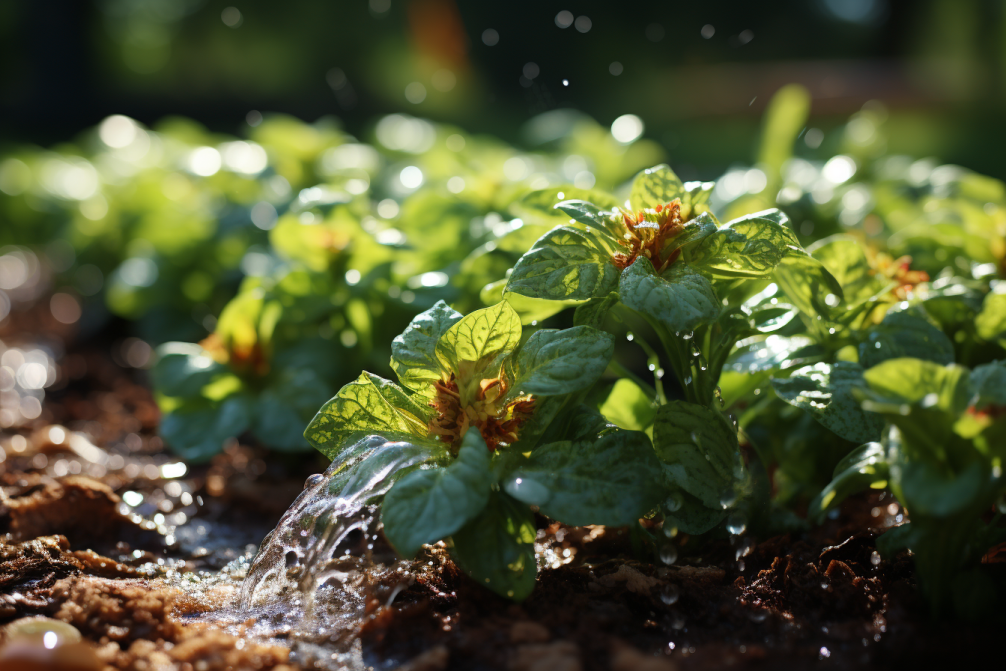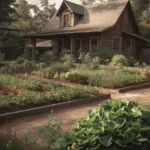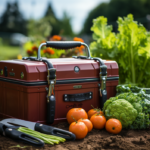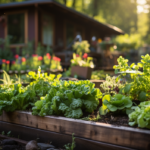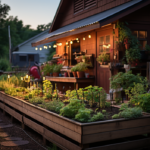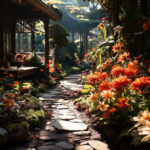Table of Contents
Save Water, Save Your Garden: Mastering Sustainable Watering Practices for Greener Gardening
Hey there, green thumbs! Are you ready to dive into the wonderful world of sustainable watering techniques in gardening? If you’re passionate about both nurturing your plants and taking care of Mother Earth, you’ve come to the right place. In this ultimate guide, we’re going to explore a variety of watering techniques that will not only keep your garden thriving but also conserve water and promote sustainability.
We all know that water is a precious resource, and with increasing concerns about global water scarcity, it’s crucial that we do our part in being more conscious and responsible with our water usage. But fret not! Adopting sustainable watering practices doesn’t mean sacrificing the vibrancy and health of your beloved plants. On the contrary, it can enhance their growth while reducing your water bill and environmental impact.
Throughout this guide, we’ll uncover the secrets of efficient watering methods such as drip irrigation, rainwater harvesting, and soil moisture monitoring. We’ll discuss the importance of proper watering schedules, mulching techniques, and water-saving tools to ensure every drop counts. Whether you’re a newbie gardener or a seasoned pro, this guide has something to offer for everyone.
So, get ready to transform your garden into a sustainable oasis. It’s time to make a splash with sustainable watering techniques that will make both your plants and the planet happy!
The Importance of Sustainable Watering Practices in Gardening
Water is an essential resource for gardening, but it’s important to use it wisely and sustainably. By adopting sustainable watering practices, not only can you save on your water bill but also contribute to the conservation of this precious resource. Let’s dive into why sustainable watering practices are crucial in gardening.
Conserving water for a greener future
Water scarcity is a pressing global issue, and every drop counts. By utilizing sustainable watering techniques, you can minimize water waste and contribute to a more sustainable future. Practices like drip irrigation and rainwater harvesting allow you to efficiently deliver water to your plants directly at the root zone, ensuring minimal evaporation or runoff.
Promoting the health of your plants and soil
Believe it or not, excessive watering can actually harm your plants. Overwatering can lead to root rot, nutrient leaching, and the growth of fungal diseases. By implementing sustainable watering practices, you can provide your plants with the right amount of water they need for healthy growth. This will result in stronger root systems, better nutrient absorption, and overall healthier plants.
Not only do sustainable watering practices benefit plants, but they also improve soil health. Consistent overwatering can compact the soil, making it less fertile and affecting oxygen levels. By following sustainable watering techniques such as mulching or using moisture sensors, you can maintain optimal soil moisture levels, encourage microbial activity, and improve overall soil structure.
Reducing water bills and environmental impact
Adopting sustainable watering practices not only benefits the environment but also your wallet. With efficient watering techniques, you can significantly reduce your water bills by using just the right amount of water needed for your plants. Additionally, by conserving water, you’ll be doing your part in reducing the strain on local water sources and the energy required for water treatment and distribution.
By implementing sustainable watering practices, you’re making a positive impact on both the health of your garden and the environment. So, let’s explore the various techniques and strategies that will allow you to achieve a beautiful, thriving garden while conserving water and promoting sustainability. It’s time to become a water-wise gardener!
Drip Irrigation: Maximizing Efficiency and Minimizing Waste
Drip irrigation is a water-efficient technique that delivers water directly to the plant’s root zone, allowing for precise and efficient watering. It involves a network of tubing with small emitters or drip heads that release water slowly and evenly near the base of each plant. This method ensures that water is delivered directly to where it’s needed, minimizing evaporation, runoff, and water waste.
Benefits of drip irrigation in sustainable gardening
Drip irrigation offers numerous benefits that make it an ideal choice for sustainable watering practices:
- Water efficiency: Drip irrigation can save up to 50% more water compared to conventional watering methods. By directly delivering water to the roots, evaporation and runoff are significantly reduced.
- Precise targeting: Each plant gets the exact amount of water it needs, preventing water wastage and optimizing plant health.
- Weed control: Drip irrigation delivers water only to the desired planting areas, minimizing moisture in weed-prone areas, and reducing weed growth.
- Reduced disease risk: By avoiding excessive leaf wetting, drip irrigation helps to reduce the risk of fungal diseases.
How to set up a drip irrigation system
Setting up a drip irrigation system may sound daunting, but it’s actually quite straightforward. Here are some key steps to guide you:
- Plan and measure: Determine the layout of your garden and measure the tubing needed. Take into consideration the water pressure and flow rate.
- Assemble the system: Connect the tubing and emitters according to your garden layout. Ensure a secure connection at each joint.
- Install the system: Lay the tubing along the plant rows, making sure to position the emitters near the plants’ root zones. Secure the system with stakes or clips.
- Connect to a water source: Attach the main tubing to a water source using a pressure regulator and filter to ensure steady water flow and prevent clogging.
- Test and adjust: Turn on the water supply and check for leaks or issues. Adjust the drip rate, if necessary, to meet the specific needs of your plants.
Drip irrigation is an efficient and effective way to water your garden sustainably. By maximizing efficiency and minimizing waste, you’ll not only save water but also promote healthier plants and soil. So, go ahead and give drip irrigation a try in your garden – your plants (and water bill!) will thank you.
Rainwater Harvesting: Harnessing Nature’s Gift for your Garden
Why rainwater harvesting is beneficial for sustainable gardening
Rainwater harvesting is an excellent technique for sustainable watering practices, as it allows you to utilize a free and abundant resource provided by nature. By collecting and storing rainwater, you can reduce your reliance on treated tap water, conserve water, and minimize your impact on the environment. Additionally, rainwater is naturally soft and free of chemicals, making it beneficial for plants.
How to collect and store rainwater effectively
To collect rainwater efficiently, there are a few key steps you should follow:
- Install a rain barrel: Place a rain barrel at the base of a downspout or under a roof area with suitable drainage. Ensure the barrel has a secure lid and a screen to keep out debris and mosquitoes.
- Position the barrel correctly: Select a location that’s convenient for accessing and using the harvested rainwater. Make sure it’s stable and leveled.
- Direct the downspout: Connect a diverter or downspout extension to your gutter system, which diverts rainwater directly into the rain barrel.
- Maintain the barrel: Regularly clean the barrel and screen to prevent clogging and maintain water quality. Use a cover to prevent sunlight and algae growth.
Utilizing rainwater in your garden
Now that you have harvested rainwater, it’s time to put it to good use:
- Water your plants: You can use the collected rainwater to directly water your garden beds, potted plants, or containers. Use a watering can, hose, or drip irrigation system to ensure precise and efficient watering.
- Supplement irrigation: During dry spells, you can supplement your regular watering schedule with stored rainwater. This helps reduce the need for tap water and ensures your plants receive sufficient hydration.
- Composting and soil amendment: Dilute collected rainwater for use in composting or as a liquid fertilizer. It adds nutrients and organic matter to enhance soil fertility and nourish your plants.
Rainwater harvesting is an eco-friendly way to water your garden and reduce your reliance on municipal water supplies. By utilizing nature’s gift, you’re able to support plant growth, reduce water bills, and promote sustainability. So, make the most of rainy days and start harvesting rainwater for your garden today!
Soil Moisture Monitoring: Finding the Perfect Balance for Watering
The importance of monitoring soil moisture
Maintaining the right balance of soil moisture is crucial for the health of your plants. Overwatering or underwatering can lead to stunted growth, root rot, or even plant death. By monitoring soil moisture levels, you can ensure that your plants receive adequate hydration without wasting water.
Different methods for monitoring soil moisture
There are several methods you can use to monitor soil moisture:
- Finger test: Insert your finger into the soil up to the first knuckle. If the soil feels dry at that depth, it’s time to water. If it feels moist, hold off on watering.
- Visual inspection: Observe the appearance of the soil. Dry soil will look lighter in color and may pull away from the edges of the planting container. Moist soil will appear darker and cling to the sides.
- Moisture meters: These handheld devices have probes that measure soil moisture levels. Simply insert the probe into the soil and read the moisture level on the display.
- Tensiometers: Tensiometers measure soil moisture tension, indicating how difficult it is for plant roots to extract water from the soil. They typically consist of a tube with a porous ceramic tip that is inserted into the ground. The device provides a reading based on the pressure needed to pull water from the soil.
How to interpret soil moisture readings
When interpreting soil moisture readings, consider the specific needs of your plants:
- Too dry: If the readings indicate that the soil is excessively dry, it’s time to water your plants. Ensure you water thoroughly to promote deep root growth.
- Just right: Moisture readings that fall within the recommended range for your specific plants indicate that watering is not yet necessary. Monitor the soil moisture level and water when it starts to dry out.
- Too wet: If the soil moisture readings indicate high moisture levels, hold off on watering. Excessive moisture can lead to root rot and other problems. Allow the soil to dry out a bit before watering again.
Monitoring soil moisture levels allows you to tailor your watering routine to meet the needs of your plants. By avoiding overwatering and underwatering, you’ll promote healthier plants and conserve water in the process. So, keep a close eye on your soil moisture and find that perfect balance for watering success!
Watering Schedules: When and How Much to Water for Optimal Growth
Establishing a watering schedule is essential for maintaining healthy plants. While the frequency of watering will depend on various factors, a general rule of thumb is to water deeply but less frequently. This encourages plants to develop deep root systems that can access moisture from lower soil levels. Consider the following when creating your watering schedule:
- Plant type and stage of growth: Different plants have varying water requirements, so take into account the specific needs of each type. Consider factors such as their stage of growth, whether they are drought-tolerant, or have shallow or deep root systems.
- Soil type and drainage: Sandy soil drains quickly, while clay soil retains water. Adjust your watering schedule accordingly. If you have poor drainage, ensure you allow the soil to dry out between watering to prevent waterlogging.
- Climate and weather conditions: Hot and arid climates require more frequent watering, while cooler and more humid conditions may require less. Monitor weather patterns and adjust watering schedules accordingly.
Factors to consider when deciding how much water to use
Determining the appropriate amount of water for your plants depends on several factors:
- Plant water needs: Assess the specific water requirements of each plant and adjust accordingly. Factors such as leaf size, growth rate, and season impact water needs.
- Transpiration rates: Transpiration is the process by which plants lose water through their leaves. Environmental conditions such as temperature, humidity, and wind affect the rate of transpiration.
- Evaporation rate: Consider how quickly water evaporates from the soil surface. Mulching can help reduce evaporation and retain soil moisture.
Tips for efficient watering
To water efficiently and avoid water wastage:
- Water in the morning: It’s best to water early in the morning when temperatures are lower, reducing water loss through evaporation.
- Direct water to the roots: Utilize watering techniques such as drip irrigation or soaker hoses to deliver water directly to the root zone, minimizing waste.
- Use mulch: Apply organic mulch around plants to conserve moisture, regulate soil temperature, and suppress weeds.
- Monitor soil moisture: Regularly check the soil moisture levels using various methods to ensure you’re neither underwatering nor overwatering your plants.
By following a well-balanced watering schedule and considering the water needs of your plants, you’ll promote optimal growth while conserving water. Remember, a little bit of planning and attention to detail will go a long way in achieving a flourishing garden!
Mulching: The Secret Weapon for Water Conservation in Gardening
Mulching is an excellent technique for conserving water and promoting sustainability in your garden. Here are some key benefits of mulching:
- Moisture retention: Mulch acts as a protective layer on the soil, reducing evaporation and helping to retain moisture. This means less frequent watering and more efficient use of water resources.
- Weed suppression: Mulch inhibits weed growth by blocking sunlight and preventing weed seeds from germinating. This saves you time and effort spent on weed control.
- Temperature regulation: Mulch helps insulate the soil, keeping it cooler in the summer and warmer in the winter. This creates a more stable and favorable environment for plant growth.
- Soil improvement: As mulch breaks down over time, it enriches the soil with organic matter, enhancing its fertility and promoting beneficial microbial activity.
Different types of mulch to consider
When selecting mulch for your garden, consider the following options:
- Organic mulch: This includes materials like wood chips, straw, leaves, grass clippings, and compost. Organic mulches break down over time, enriching the soil and improving its water-holding capacity.
- Inorganic mulch: Inorganic mulches such as gravel, rocks, or rubber chips are long-lasting and offer weed suppression and moisture retention benefits. However, they do not contribute to soil fertility.
How to apply mulch effectively
To get the most out of your mulching efforts, follow these tips:
- Prepare the soil: Before applying mulch, weed the area and ensure the soil is moist. This will help with weed suppression and aid in moisture retention.
- Apply a thick layer: Spread a layer of mulch around your plants, aiming for a thickness of 2-4 inches. Thicker mulch prevents weed growth and provides better insulation.
- Keep mulch away from plant stems: Leave a small gap between the mulch and the stems of your plants to avoid moisture buildup and potential rot.
- Maintain mulch depth: Over time, organic mulches break down, so replenish them annually to maintain the desired thickness.
Mulching is a simple yet powerful technique for conserving water and promoting sustainable gardening practices. By using the right mulch and applying it effectively, you’ll create an environment that retains moisture, suppresses weeds, and supports healthy plant growth. So get your mulch on and watch your garden thrive!
Water-Saving Tools and Technology: Innovations for Sustainable Watering
With advancements in technology, we now have a range of tools and innovations that can help us achieve more sustainable watering practices in our gardens. These tools not only save water but also promote efficient irrigation and enhance plant health. Let’s explore some essential water-saving tools and technological advancements that can transform the way we water our gardens.
Essential water-saving tools for efficient watering
- Rainwater harvesting systems: Collecting rainwater through barrels or tanks allows you to harness nature’s gift and use it for watering your plants. This reduces reliance on municipal water supplies and conserves water resources.
- Drip irrigation systems: Drip irrigation delivers water directly to the root zone of plants, minimizing evaporation and runoff. It ensures that water is delivered precisely where it’s needed, promoting efficient and targeted watering.
- Soil moisture sensors: These sensors measure the moisture level in the soil, allowing you to water your plants only when necessary. They provide real-time data, helping you avoid under or overwatering and ensuring optimal soil moisture levels.
- Smart irrigation controllers: These innovative controllers use weather data, soil moisture readings, and other factors to adjust watering schedules automatically. They optimize water usage by adjusting irrigation based on real-time conditions, saving water and reducing waste.
Technological advancements for smarter water management
- Smartphone apps: There are various apps available that provide information on weather patterns, local water restrictions, and watering recommendations. These apps can help you make informed decisions about when and how much to water your garden.
- Water-efficient sprinklers and nozzles: New sprinkler technologies, such as rotating heads and adjustable nozzles, distribute water more efficiently, reducing overspray and evaporation.
- Remote watering systems: These systems allow you to control and monitor your garden’s watering remotely. With features like customizable schedules and real-time notifications, you can ensure your garden receives the right amount of water, even when you’re away.
Water-saving tools and technologies empower us to be more efficient in our watering practices, conserve water, and promote sustainability in gardening. By incorporating these innovations into our routines, we can achieve thriving gardens while minimizing water waste. Embrace these tools and let technology lend a helping hand in creating an environmentally responsible and water-efficient garden.
Overcoming Common Challenges: Dealing with Drought and Water Restrictions
Drought conditions and water restrictions can present significant challenges for gardeners. Water scarcity can impact the health and growth of your plants, while water restrictions may limit the amount of water you can use for gardening. However, with some smart strategies and adjustments to your watering practices, you can keep your garden thriving even during challenging times.
Strategies for conserving water during drought periods
During drought periods, it’s crucial to conserve water and use it efficiently. Here are some strategies to consider:
- Mulching: Apply a thick layer of organic mulch around your plants to retain soil moisture, suppress weeds, and reduce evaporation.
- Watering deeply: Instead of frequent shallow watering, water your plants deeply but less frequently. This allows the water to penetrate deeper into the root zone, encouraging stronger and more drought-tolerant roots.
- Time watering wisely: Water your plants early in the morning or late in the evening when temperatures are cooler. This reduces water loss due to evaporation.
- Collect and reuse water: Collect and reuse water whenever possible. Use rain barrels to capture rainwater, and repurpose household water, such as kitchen sink or shower runoff, for your plants.
Adapting watering techniques to comply with water restrictions
When faced with water restrictions, it’s important to adjust your watering practices to comply with local regulations. Here’s how you can adapt:
- Prioritize watering: Focus on watering your most valuable or vulnerable plants rather than trying to evenly water everything.
- Switch to drip irrigation: If allowed, consider switching to a drip irrigation system. Drip irrigation is highly efficient and delivers water directly to the roots, minimizing water loss.
- Use watering cans or handheld nozzles: Opt for targeted watering with watering cans or handheld nozzles instead of sprinklers to avoid water wastage.
- Explore alternative methods: Look into water-saving techniques such as hydroponics or xeriscaping, which require minimal water usage.
During drought and water restrictions, it’s essential to be mindful of your water usage and make adjustments to ensure both the survival of your garden and compliance with regulations. By being proactive and implementing these water-saving strategies, you can navigate through challenging times while still enjoying the beauty and benefits of a sustainable garden.
Landscaping for Water Efficiency: Designing a Sustainable Garden
Designing a water-efficient garden is not only about conserving water but also creating a sustainable and visually appealing space. Water-efficient landscaping helps reduce water waste, lowers your water bill, and supports the health of your plants by providing them with the right amount of water. By implementing water-efficient design principles, you can create a beautiful garden that minimizes environmental impact.
Elements of a water-efficient garden design
- Plant selection: Choose native or drought-tolerant plant species that are well-suited to your climate. These plants have adapted to local conditions and require less water to thrive.
- Grouping and zoning: Group plants together based on their water needs. This allows you to water more efficiently, providing different zones with varying water requirements.
- Proper soil preparation: Improve your soil’s water-holding capacity by adding organic matter, such as compost. Well-amended soil retains water better and promotes stronger root growth.
- Mulching: Apply mulch around your plants to retain moisture, inhibit weed growth, and regulate soil temperature. Mulch acts as a protective layer, reducing water evaporation from the soil surface.
Tips for creating a sustainable and water-wise garden
- Efficient irrigation: Install a drip irrigation system or use soaker hoses to deliver water directly to the plant roots. These methods minimize water loss through evaporation or runoff.
- Rainwater harvesting: Capture rainwater using rain barrels or cisterns and utilize it for watering your garden. This sustainable practice helps reduce reliance on freshwater sources.
- Smart use of hardscape: Incorporate permeable surfaces, such as gravel or permeable pavers, in your garden design. These surfaces allow water to penetrate the soil instead of running off, reducing erosion and promoting groundwater recharge.
- Appropriate lawn size: Consider minimizing or eliminating large expanses of turfgrass, as lawns typically require a significant amount of water to maintain. Instead, opt for low-maintenance alternatives or create functional outdoor living spaces.
Creating a water-efficient garden is about designing a sustainable and beautiful space that conserves water while supporting plant growth and biodiversity. By incorporating these principles into your landscaping, you can enjoy a stunning garden that reduces water consumption and contributes to a greener future.
Watering Do’s and Don’ts: Best Practices for Sustainable Gardening
Do’s
- Do water deeply: Water your plants deeply, ensuring that the water reaches the root zone. This promotes healthy root growth and reduces the frequency of watering.
- Do water early in the morning: Water your garden in the early morning when temperatures are cooler. This allows plants to absorb water before the heat of the day, minimizing evaporation.
- Do use mulch: Apply a layer of mulch around your plants to conserve moisture, suppress weeds, and regulate soil temperature. This helps to reduce water loss through evaporation and keeps the soil consistently moist.
- Do use efficient watering techniques: Utilize water-saving techniques like drip irrigation or soaker hoses. These methods deliver water directly to the plants’ roots, reducing water waste and promoting efficient absorption.
Don’ts
- Don’t overwater: Overwatering can lead to root rot and other plant health issues. Avoid excessive watering by checking soil moisture levels before watering and adjusting the frequency accordingly.
- Don’t water during the hottest part of the day: Watering when the sun is at its peak can lead to significant water loss through evaporation. It’s best to avoid watering during the hottest hours to maximize water efficiency.
- Don’t rely solely on sprinklers: Sprinklers, while convenient, can result in water wastage due to evaporation and overspray. Use more targeted watering methods, such as drip irrigation or watering cans, for efficient water delivery.
- Don’t water unnecessary areas: Focus your watering efforts on the plant root zones rather than watering surrounding areas, such as walkways or driveways. This prevents water waste and ensures water is used where it is needed most.
By following these do’s and don’ts, you can maximize water efficiency in your garden, promote plant health, and contribute to sustainable gardening practices. Remember, being mindful of your watering habits goes a long way in creating a thriving and environmentally friendly garden.
Conclusion
Well, there you have it, fellow green thumbs! We’ve covered the essentials in this ultimate guide to sustainable watering techniques in gardening. From understanding the importance of conserving water to implementing efficient practices, you now have the knowledge to create a greener and more sustainable garden.
By adopting strategies like drip irrigation, rainwater harvesting, and soil moisture monitoring, you can make a big difference in water conservation while keeping your plants happy and healthy. Mulching, smart watering schedules, and utilizing the right tools and technology further enhance your garden’s eco-friendliness.
Remember, sustainability is all about finding that perfect balance. It’s about nurturing the beauty of nature while being mindful of our precious resources. With every drop of water saved and every watering practice adjusted, you’re making a positive impact on the environment.
So, go ahead and put these techniques into action. Let’s create gardens that flourish with vibrant blooms, lush foliage, and bountiful harvests, all while protecting and preserving our planet. Together, we can cultivate a sustainable future, one garden at a time. Happy gardening, my eco-conscious friends!

